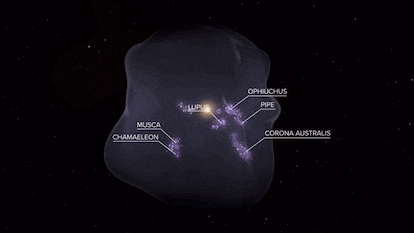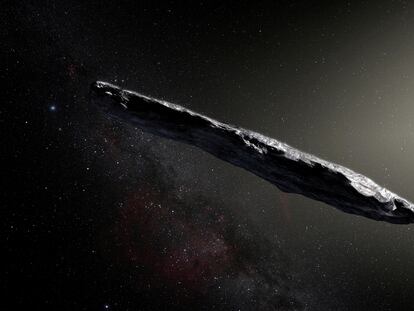We really do live inside a bubble (and it’s not social media)
The Solar System is sitting at the center of a cavity of hot gas that was formed by exploding supernovae and whose expansion is driving star formation near the Sun

Fourteen million years ago, the Sun was about 900 light years away from an exploding supernova. The amount of energy associated with this stellar explosion resulted in the formation of a bubble of hot gas in the interstellar medium. At that time our distant relatives, the first great apes, were beginning to appear on Earth.
Only nine million years later, our ancestors were becoming a distinct branch of bipeds, and the Sun and all the planets in the Solar System had entered that bubble. Because our star moves at a different velocity from its immediate surroundings, we are now, five million years after that, at the center of the bubble, about 150 light years from its surface in each direction.
And thank goodness we –or rather the orangutans – were far away when the first of the 15 supernovae responsible for the formation of the bubble exploded. A kind of very hot explosive soap bubble, the phenomenon is known as the Local Bubble and resembles a 1,000,000º C bain-marie in which the entire Solar System is immersed. We do not know if it is closed or broken. It could be what we know as a galactic chimney, burst on the outside a few hundred light years above and below the plane of our galaxy.
We have known of its existence for years. It is expanding at about seven kilometers per second (4.3 miles per second); in the time you’ve been reading this, it has advanced 280 kilometers (174 miles). It gains ground in the “normal” interstellar medium where we find one atom every 10 cubic centimeters or so at temperatures of 6,000-7,000º C. To find an atom in the bubble, we have to increase the volume to 1,000 cubic centimeters and it occurs to me that the X-rays it emits could be used by extraterrestrials to examine our suitcases should we try to leave the Solar System.
On a more serious note, the fact is that recent data from the European satellite Gaia has allowed us to make a three-dimensional map of the environment in which we live, throwing up important clues about the effect of the Local Bubble and the energy it releases. To map our environment, Gaia has to measure the positions and velocity of stars and gas and dust clouds and reconstruct their motion. It’s like having a track full of bumper cars with the possibility of taking nothing more than a “snapshot” of their velocity and position from the center of the track. But our stars can also move up and down; they can leave the track and travel through vertical space. With these snapshots, we have to reconstruct exactly where they were when the horn sounded and everything started moving. It is complicated. But Gaia’s reconstruction of the motion and position of the stars is revealing.
The observed geometry and motion indicate that in all the regions where star formation is occurring 650 light years from the Sun, this is a consequence of the expansion of the Local Bubble. This is fascinating, especially because supernovae are like fictional characters and can be either good guys or bad guys, depending on the circumstances. The debate, which has been going on for many years in scientific circles, tries to decipher whether these explosions, which are among the most energetic in the universe, destroy everything in their path or, on the contrary, provide the basic elements needed by the clouds of interstellar gas to start forming stars.
It seems that the Local Bubble, which has required the explosion of about 15 supernovae to form, has worked as a kind of piston. The expansion compresses the gas, triggering star formation on the bubble’s surface. Supernova explosions form stars. Period. There is now robust support for this theory, thanks to Gaia and the team led by astrophysicist Catherine Zucker whose research has just been published.
Tu suscripción se está usando en otro dispositivo
¿Quieres añadir otro usuario a tu suscripción?
Si continúas leyendo en este dispositivo, no se podrá leer en el otro.
FlechaTu suscripción se está usando en otro dispositivo y solo puedes acceder a EL PAÍS desde un dispositivo a la vez.
Si quieres compartir tu cuenta, cambia tu suscripción a la modalidad Premium, así podrás añadir otro usuario. Cada uno accederá con su propia cuenta de email, lo que os permitirá personalizar vuestra experiencia en EL PAÍS.
¿Tienes una suscripción de empresa? Accede aquí para contratar más cuentas.
En el caso de no saber quién está usando tu cuenta, te recomendamos cambiar tu contraseña aquí.
Si decides continuar compartiendo tu cuenta, este mensaje se mostrará en tu dispositivo y en el de la otra persona que está usando tu cuenta de forma indefinida, afectando a tu experiencia de lectura. Puedes consultar aquí los términos y condiciones de la suscripción digital.
More information
Últimas noticias
The complicated life of Francesca Albanese: A rising figure in Italy but barred from every bank by Trump’s sanctions
Pinochet’s victims grapple with José Antonio Kast’s rise in Chile
Reinhard Genzel, Nobel laureate in physics: ‘One-minute videos will never give you the truth’
How Japan is trying to avert ‘digital defeat’
Most viewed
- Why we lost the habit of sleeping in two segments and how that changed our sense of time
- Pablo Escobar’s hippos: A serious environmental problem, 40 years on
- Trump’s obsession with putting his name on everything is unprecedented in the United States
- The Florida Keys tourist paradise is besieged by immigration agents: ‘We’ve never seen anything like this’
- Charles Dubouloz, mountaineering star, retires at 36 with a farewell tour inspired by Walter Bonatti











































